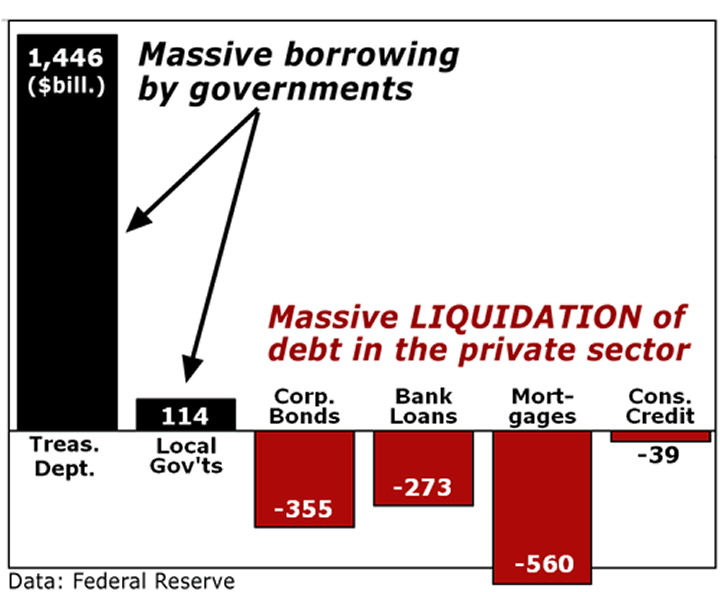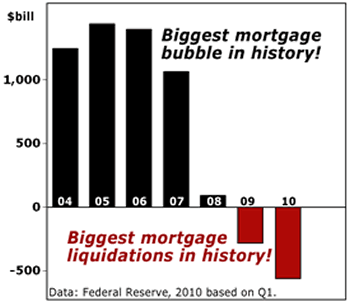Bernanke Hallucinating That Printing Money and Buying Bonds Can Save the Economy
Interest-Rates / US Debt Aug 30, 2010 - 07:42 AM GMTBy: Martin_D_Weiss
 If Fed Chairman Ben Bernanke honestly believes what he said at Jackson Hole on Friday — that he can save the economy by printing more money and buying more bonds — he’s hallucinating.
If Fed Chairman Ben Bernanke honestly believes what he said at Jackson Hole on Friday — that he can save the economy by printing more money and buying more bonds — he’s hallucinating.
Through the first quarter of this year, he printed $1.5 trillion of paper money and promptly bought $1.5 trillion in mortgage bonds, government agency bonds, and Treasury bonds.
But the entire effort was a dismal failure; the U.S. economy is still sinking and most large American banks are still weak.
The underlying reason: While the government has been borrowing massively, nearly everyone else has embarked on unprecedented debt LIQUIDATIONS.
In other words …
While Washington is gorging itself on new debts, nearly every other sector is undergoing massive liposuctions.
How do we know? Because that’s what the Federal Reserve itself is reporting — unambiguously and conclusively.
|
Based on the Fed’s latest Flow of Funds report (Table F4, “Credit Market Borrowing”), governments are borrowing massively.
But the collapse in private sector credit is so dramatic that among ALL the major categories the Fed tracks, NOT ONE is expanding its debts. Rather, every single sector is in advanced stages of unprecedented and massive debt liquidations!
Specifically, as you can see in the chart above …
- Corporations are cutting back on their bonds at a record pace of $355 billion per year …
- Banks are cutting back on their lending at the yearly rate of $273 billion, and …
- Worst of all, mortgages are being liquidated at a record-smashing pace of $560 billion annually.
In addition, the Fed is reporting net cutbacks in consumer credit ($39 billion), open market paper ($154 billion), agency bonds ($16 billion), and other loans ($174 billion).
And remember: We’re not just talking about a slowdown in the pace of new borrowing — the pattern we used to see in typical recessions of the past. No! These are actual net reductions in debts outstanding — the basic stuff that depressions are made of.
In sum, nearly all the money Bernanke has printed — plus all the money he has supposedly poured into the economy — is going nowhere, except perhaps down the drain. He’s clearly running on a treadmill … pushing on a string.
Whatever you do, do not underestimate the potential impact of this situation. It is …
Huge! Including both the government and private sectors, the total new credit created in 2007 was $4.5 trillion. Now, it’s running at an annual pace of about ZERO! That $4.5 trillion was LOT of money — and it’s all money that’s NOT pouring into the economy any more.
Unprecedented!This has never happened before in modern times — not even during the deepest recession of the postwar era. During the Great Depression? Yes. But in proportion to GDP, the debt buildup before the Depression — as well as the debt liquidations during the Depression — were not as large as they are now.
Getting worse!Despite everything Bernanke has done to try to stop it, the debt liquidations are accelerating — especially in the mortgage area. Consider these basic facts:
|
Back in 2005, lenders issued $1.4 trillion in new mortgages over and above those that were paid off or went bad — a fantastic amount of fresh new money pouring into the housing and construction markets.
But by 2008, they had cut back their new mortgage lending by a whopping 94 percent. The industry virtually died — an unmitigated disaster for the economy.
At that point, pundits assumed it was the end of the decline. On a net basis, the creation of mortgages in the U.S. was practically down to zero. “So how much further could it possibly fall?” they asked.
Meanwhile, Bernanke apparently assumed that, by buying crazy, unprecedented amounts of mortgage bonds, he could somehow stop the decline — or at least offset its impact. But the decline in the mortgage market didn’t end there in 2008 …
In 2009, it got worse — a lot worse! Not only was new mortgage money largely unavailable but OLD mortgage money was pulled out. Result: We saw net mortgage liquidations of $283 billion!
And for the first quarter of 2010, as I highlighted earlier, the Fed reports net liquidations running at an annual pace of $560 billion, the worst in history.
The Unavoidable Consequences
These forces are more enduring than any monetary policy, bigger than any government. They are unmistakable, unavoidable, and overwhelming.
Bernanke can try to make believe they don’t exist. But you cannot afford to take that risk. You must recognize the truth and consequences that he’s not talking about …
Consequence #1. Bernanke’s nearly powerless. No matter how many more bonds he buys, Bernanke cannot save the recovery. Sure, he could push 30-year fixed mortgage rates down some more. But even the lowest mortgage rates in recorded history haven’t made a bit of difference. In fact, despite low rates, mortgages are being liquidated at an even FASTER clip. Home sales falling even MORE rapidly.
Consequence #2. Double dip. The double-dip recession we’ve been warning you about is now on its way. Meanwhile, administration economists still swear on a stack of Bibles that the double dip is not in the cards; and private economists think the probability of a double dip is only 20 to 30 percent. They must be getting their hallucinogens from the same source as Bernanke.
Consequence #3. More bank failures! As a whole, despite government bailouts and regulatory reform, the nation’s banks and thrifts are no healthier today than they were before the onset of the debt crisis. The big difference: This time the government is unlikely to have nearly as much political or financial capital to bail them out.
What To Do
First, reduce your risk exposure. Sell any stock or investment that may be vulnerable to a double-dip recession and all its probable consequences.
Second, hedge. If you are unable or unwilling to sell, buy some protection. The most convenient vehicle: Inverse ETFs — exchange traded funds that are designed to rise in value as markets decline.
Third, get your money to safety. Despite the near-zero yields, short-term U.S. Treasury bills or Treasury-only money market funds are still the safest parking place.
Fourth, check your bank. Click this link to review our list of the Weakest Banks and Thrifts in the U.S.
This list includes only institutions with a Weiss Rating of D+ (weak) or lower — institutions we believe to be vulnerable to future financial difficulties or even failure. To be sure, many vulnerable institutions will NOT ultimately fail. However, we believe that their risk of failure is high.
For your convenience, we’ve listed them by state, then in alphabetical order. Plus, with each institution, we provide not only the company name, but also their state of domicile and their total assets.
This extra information is important because there are many banks in different states that have very similar names, and we don’t want you to make a critical decision based on a case of mistaken identity. So make sure you’ve got the exact name of your institution. And if you’re still not certain, double-check by asking your banker to identify their state of domicile.
So … is your bank on our Weakest list? Or not?
- If your bank is NOT on Weakest list, it’s because it has received a rating of AT LEAST C- (fair). Now, C is not a good rating. But it means that we believe your bank is stable and not currently vulnerable.
- If your bank IS on the Weakest list, it means we believe your bank is vulnerable.
If so, we recommend you click here to review our list of the Strongest Banks and Thrifts in the U.S.
This list includes only institutions with a Weiss Rating of B+ (good) or higher. We do not guarantee that all of these institutions are completely safe. However, we believe that their risk of failure is very low.
At the top of the page, click on your state. Then, shop among the listed banks in your area.
Finally, above all …
Do not believe Bernanke! Given all the facts he has at his fingertips — the same ones I’ve just presented here this morning — I doubt he even believes himself.
Good luck and God bless!
Martin
This investment news is brought to you by Money and Markets. Money and Markets is a free daily investment newsletter from Martin D. Weiss and Weiss Research analysts offering the latest investing news and financial insights for the stock market, including tips and advice on investing in gold, energy and oil. Dr. Weiss is a leader in the fields of investing, interest rates, financial safety and economic forecasting. To view archives or subscribe, visit http://www.moneyandmarkets.com.
© 2005-2022 http://www.MarketOracle.co.uk - The Market Oracle is a FREE Daily Financial Markets Analysis & Forecasting online publication.





